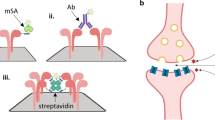Abstract
The avidin—biotin bond is the strongest known biological interaction between a ligand and a protein (K d=1.3×10−15 M at pH 5.0) (1). The affinity is so high that the avidin—biotm complex is extremely resistant to any type of denaturing agent (2). Biotin (Fig. 1) is a small, hydrophobic molecule that functions as a coenzyme of carboxylases (3). It is present in all living cells. Avidin is a tetrameric glycoprotein of 66,000–68,000 molecular weight, found in egg albumin and in avian tissues. The interaction between avidin and biotin occurs rapidly, and the stability of the complex has prompted its use for in situ attachment of labels in a broad variety of applications, including immunoassays, DNA hybridization (4–6), and localization of antigens in cells and tissues (7). Avidin has an isoelectric point of 10.5. Because of its positively charged residues and its oligosaccharide component, consisting mostly of mannose and glucosamine (8), avidin can interact nonspecifically with negative charges on cell surfaces and nucleic acids, or with membrane sugar receptors. At times, this causes background problems in histochemical and cytochemical applications. Streptavidin, a near-neutral, biotin-binding protein (9) isolated from the culture medium of Streptomyces avidinii, is a tetrameric nonglycosylated analog of avidin with a molecular weight of about 60,000. Like avidin, each molecule of streptavidin binds four molecules of biotin, with a similar dissociation constant. The two proteins have about 33% sequence homology, and tryptophan residues seem to be involved in their biotin binding sites (10,11).

Structure of biotin.
Access this chapter
Tax calculation will be finalised at checkout
Purchases are for personal use only
Similar content being viewed by others
References
Green, N. M. (1963) Avidin 3. The nature of the biotin binding site Biochem J 89, 599–609
Green, N. M. (1963) Avidin 4. Stability at extremes of pH and dissociation into subumts by guanidine hydrochloride Biochem J 89, 609–620
Knappe, J (1970) Mechanism of biotin action. Annu Rev Biochem 39, 757–776
Wilchek, M and Bayer, E. A (1988) The avidin-biotin complex in bioanalytical applications Anal Biochem 171, 1–32
Wilchek, M and Bayer, E A (1990) Avidin-biotin technology, in Methods in Enzymology, vol 184, Academic, New York, pp 213–217
Levi, M., Sparvoh, E, Sgorbati, S., and Chiantante, D. (1990) Biotin-streptavidin immunofluorescent detection of DNA replication in root menstems through Brd Urd incorporation: cytological and microfluorimetric applications Physiol Plantarum 79, 231–235
Armstrong, R, Friedrich, V L, Jr, Holmes, K V, and Dubois-Dalcq, M (1990) In vitro analysis of the oligodendrocyte lineage in mice during demyehnation and remyehnation J. Cell Biol 111, 1183–1195
Bruch, R C and White, H B, III (1982) Compositional and structural heterogeneity of avidin glycopeptides. Biochemistry 21, 5334–5341
Hiller, Y., Gershoni, J M, Bayer, E A, and Wilchek, M. (1987) Biotin binding to avidin. oligosaccharide side chain not required for ligand association Biochem J 248, 167–171
Green, N M (1975) Avidin, in Advances in Protein Chemistry, vol 29 (Anfinsen, C B, Edsall, J. T, and Richards, F M, eds.), Academic, New York, pp 85–133
Chaiet, L and Wolf, F. J (1964) The properties of streptavidin, a biotin-binding protein produced by Streptomycetes Arch Biochem Biophys 106, 1–5.
Alon, R, Bayer, E A, and Wilcheck, M (1990) Streptavidin contains an Ryd sequence which mimics the RGD receptor domain of fibronectin Biochem Biophys Res. Commun 170, 1236–1241
Wilchek, M. and Bayer, E A. (1993) Avidm-biotin immobilization systems, in Immobilized Macromolecules Application Potentials (Sleytr, U B, ed), Springer-Verlag, New York, pp. 51–60
Gretch, D R., Suter, M, and Stinski, M. F (1987) The use of biotinylated monoclonal antibodies and streptavidin affinity chomatography to isolate Herpes virus hydrophobic proteins or glycoproteins Anal Biochem 163, 270–277
Hnatowich, D J, Virzi, F, and Rusckowski, M (1987) Investigations of avidin and biotin for imaging applications J Nucleic Med 28, 1294–1302
Haugland, R. P. (1996) Biotin and Haptens, in Handbook of Fluorescent Probes and Research Chemicals, 6th ed. (Spence, M, ed), Molecular Probes, Inc., Eugene, OR, Chapter 4
LaRochelle, W J. and Froehner, S. C. (1986) Determination of the tissue distributions and relative concentrations of the postsynaptic 43-kDa protem and the acetylcholine receptor in Torpedo J Biol Chem 261, 5270–5274
Briggs, J. and Panfili, P R (1991) Quantitation of DNA and protein impurities in biopharmaceuticals Anal Chem 63, 850–859
Wong, S. S. (1991) Reactive groups ofproteins and their modifying agents, in Chemistry of Protein Conjugation and Crosshnking, CRC, Boston, MA, pp 27–29
Kohanski, R A. and Lane, M D (1985) Receptor affinity chomatography Ann NY Acad Sci 447, 373–385
Orr, G A. (1981) The use of the 2-iminobiotin-avidin interaction for the selective retrieval of labeled plasma membrane components J Biol Chem 256, 761–766
Hoffmann, K, Wood, S W., Brinton, C C, Montibeller, J A., and Finn, F. M (1980) Immobiotin affinity columns and their application to retrieval of streptavidin. Proc Natl Acad. Sci USA 77, 4666–4668
Author information
Authors and Affiliations
Editor information
Editors and Affiliations
Rights and permissions
Copyright information
© 1998 Humana Press Inc., Totowa, NJ
About this protocol
Cite this protocol
Haugland, R.P., You, W.W. (1998). Coupling of Antibodies with Biotin. In: Pound, J.D. (eds) Immunochemical Protocols. Methods in Molecular Biology™, vol 80. Humana Press. https://doi.org/10.1007/978-1-59259-257-9_17
Download citation
DOI: https://doi.org/10.1007/978-1-59259-257-9_17
Publisher Name: Humana Press
Print ISBN: 978-0-89603-493-8
Online ISBN: 978-1-59259-257-9
eBook Packages: Springer Protocols




